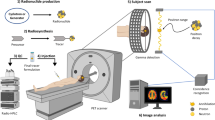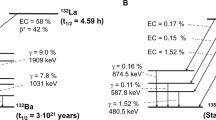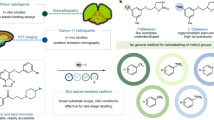Abstract
Developing targeted α-therapies has the potential to transform how diseases are treated. In these interventions, targeting vectors are labelled with α-emitting radioisotopes that deliver destructive radiation discretely to diseased cells while simultaneously sparing the surrounding healthy tissue. Widespread implementation requires advances in non-invasive imaging technologies that rapidly assay therapeutics. Towards this end, positron emission tomography (PET) imaging has emerged as one of the most informative diagnostic techniques. Unfortunately, many promising α-emitting isotopes such as 225Ac and 227Th are incompatible with PET imaging. Here we overcame this obstacle by developing large-scale (Ci-scale) production and purification methods for 134Ce. Subsequent radiolabelling and in vivo PET imaging experiments in a small animal model demonstrated that 134Ce (and its 134La daughter) could be used as a PET imaging candidate for 225AcIII (with reduced 134CeIII) or 227ThIV (with oxidized 134CeIV). Evaluating these data alongside X-ray absorption spectroscopy results demonstrated how success relied on rigorously controlling the CeIII/CeIV redox couple.

This is a preview of subscription content, access via your institution
Access options
Access Nature and 54 other Nature Portfolio journals
Get Nature+, our best-value online-access subscription
$29.99 / 30 days
cancel any time
Subscribe to this journal
Receive 12 print issues and online access
$259.00 per year
only $21.58 per issue
Buy this article
- Purchase on Springer Link
- Instant access to full article PDF
Prices may be subject to local taxes which are calculated during checkout





Similar content being viewed by others
Data availability
All data and experimental details supporting the findings discussed here are available within the paper and its Supplementary Information.
References
Kratochwil, C. et al. 225Ac-PSMA-617 for PSMA-targeted α-radiation therapy of metastatic castration-resistant prostate cancer. J. Nucl. Med. 57, 1941–1944 (2016).
Jiang, Z., Revskaya, E., Fisher, D. R. & Dadachova, E. In vivo evaluation of free and chelated accelerator-produced actinium-225—radiation dosimetry and toxicity results. Curr. Radiopharm. 11, 215–222 (2018).
McDevitt, M. R. et al. Feed-forward alpha particle radiotherapy ablates androgen receptor-addicted prostate cancer. Nat. Commun. 9, 1629 (2018).
Nikula, T. K. et al. Alpha-emitting bismuth cyclohexylbenzyl DTPA constructs of recombinant humanized anti-CD33 antibodies: pharmacokinetics, bioactivity, toxicity and chemistry. J. Nucl. Med. 40, 166–176 (1999).
Couturier, O. et al. Cancer radioimmunotherapy with alpha-emitting nuclides. Eur. J. Nucl. Med. Mol. Imaging 32, 601–614 (2005).
Kim, Y.-S. & Brechbiel, M. W. An overview of targeted alpha therapy. Tumor Biol 33, 573–590 (2012).
Thiele, N. A. & Wilson, J. J. Actinium-225 for targeted α therapy: coordination chemistry and current chelation approaches. Cancer Biother. Radiopharm. 33, 336–348 (2018).
Mastren, T. E., Ferrier, M. G., Fassbender, M. E., Birnbaum, E. R. & John, K. D. The Heaviest Metals: Science and Technology of the Actinides and Beyond (Wiley, 2017).
Becker, K. V. et al. Cross section measurements for proton induced reactions on natural La. Nucl. Instrum. Methods Phys. Res. B 468, 81–88 (2020).
Kapoor, V., McCook, B. M. & Torok, F. S. An introduction to PET-CT imaging. Radiographics 24, 523–543 (2004).
Mikolajczak, R., van der Meulen, N. P. & Lapi, S. E. Radiometals for imaging and theranostics, current production, and future perspectives. J. Label. Compd. Radiopharm. 62, 615–634 (2019).
Boros, E., Dyson, P. J. & Gasser, G. Classification of metal-based drugs according to their mechanisms of action. Chem 6, p41-60 (2019).
Brown, M. A., Paulenova, A. & Gelis, A. V. Aqueous complexation of thorium(iv), uranium(iv), neptunium(iv), plutonium(iii/iv), and cerium(iii/iv) with DTPA. Inorg. Chem. 51, 7741–7748 (2012).
Nash, K. L. The chemistry of TALSPEAK: a review of the science. Solvent Extr. Ion Exch. 33, 1–55 (2015).
Lamart, S. et al. Bringing up to date the french database of nuclear workers contaminated with plutonium and/or americium and treated with Ca-DTPA. BIO Web Conf. 14, 04011 (2019).
Yan, T.-T. et al. Pharmacological treatment of inhalation injury after nuclear or radiological incidents: the Chinese and German approach. Mil. Med. Res. 6, 10 (2019).
Wilbur, D. S. in Radiopharmaceutical Chemistry 409–424 (Springer, 2019); https://doi.org/10.1007/978-3-319-98947-1_23
Sturzbecher-Hoehne, M., Choi, T. A. & Abergel, R. J. Hydroxypyridinonate complex stability of group (iv) metals and tetravalent f-block elements: the key to the next generation of chelating agents for radiopharmaceuticals. Inorg. Chem. 54, 3462–3468 (2015).
Deblonde, G. J.-P., Lohrey, T. D. & Abergel, R. J. Inducing selectivity and chirality in group iv metal coordination with high-denticity hydroxypyridinones. Dalt. Trans 48, 8238–8247 (2019).
Deblonde, G. J.-P., Sturzbecher-Hoehne, M. & Abergel, R. J. Solution thermodynamic stability of complexes formed with the octadentate hydroxypyridinonate ligand 3,4,3-LI(1,2-HOPO): a critical feature for efficient chelation of lanthanide(iv) and actinide(iv) Ions. Inorg. Chem. 52, 8805–8811 (2013).
Deri, M. A. et al. Alternative chelator for 89Zr radiopharmaceuticals: radiolabeling and evaluation of 3,4,3-(LI-1,2-HOPO). J. Med. Chem. 57, 4849–4860 (2014).
Miederer, M., Scheinberg, D. A. & McDevitt, M. R. Realizing the potential of the actinium-225 radionuclide generator in targeted alpha particle therapy applications. Adv. Drug Deliv. Rev. 60, 1371–1382 (2008).
Davis, I. A. et al. Comparison of 225actinium chelates: tissue distribution and radiotoxicity. Nucl. Med. Biol. 26, 581–589 (1999).
Ramdahl, T. et al. An efficient chelator for complexation of thorium-227. Bioorg. Med. Chem. Lett. 26, 4318–4321 (2016).
Benjamin, R. O. et al. In-vivo comparison of thorium-227 and zirconium-89 labeled 3,2-HOPO mesothelin antibody–chelator conjugate. J. Med. Imaging Radiat. Sci. 50, S26 (2019).
Hagemann, U. B. et al. In vitro and in vivo efficacy of a novel CD33-targeted Thorium-227 conjugate for the treatment of acute myeloid leukemia. Mol. Cancer Ther. 15, 2422–2431 (2016).
Hammer, S. et al. Abstract 5200. Preclinical pharmacology of the PSMA-targeted thorium-227 conjugate PSMA-TTC: a novel targeted alpha therapeutic for the treatment of prostate cancer. Cancer Res 77, 5200–5200 (2017).
Richmond, C. R. & London, J. E. Long-term in vivo retention of cerium-144 by beagles. Nature 211, 1179 (1966).
Leggett, R. et al. Biokinetic data and models for occupational intake of lanthanoids. Int. J. Radiat. Biol. 90, 996–1010 (2014).
Ewaldsson, B. & Magnusson, G. Distribution of radiocerium and radiopromethium in mice: an autoradiographic study. Acta Oncol. 2, 65–72 (1964).
Evans, W. J., Deming, T. J. & Ziller, J. W. The utility of ceric ammonium nitrate-derived alkoxide complexes in the synthesis of organometallic cerium(iv) complexes: synthesis and first X-ray crystallographic determination of a tetravalent cerium cyclopentadienide complex, (C5H5)3Ce(OCMe3). Organometallics 8, 1581–1583 (1989).
Greco, A., Cesca, S. & Bertolini, W. New 7r-cyclooctate’I’raenyl and iT-cyclopentadienyl complexes of cerium. J. Organomet. Chem. 113, 321–330 (1976).
Streitwieser, A., Kinsley, S. A., Rigsbee, J. T., Fragala, I. L. & Ciliberto, E. Photoelectron spectra and bonding in cerocene, bis(π-[8]annulene)cerium(iv). J. Am. Chem. Soc. 107, 7786–7788 (1985).
Klamm, B. E. et al. Experimental and theoretical comparison of transition-metal and actinide tetravalent schiff base coordination complexes. Inorg. Chem. 57, 15389–15398 (2018).
Qiao, Y. & Schelter, E. J. Lanthanide photocatalysis. Acc. Chem. Res. 51, 2926–2936 (2018).
Wong, W.-H. et al. Synthesis, structure, and reactivity of tetravalent cerium complexes containing oxidizing oxyanion ligands. J. Organomet. Chem. 899, 120902 (2019).
Assefa, M. K. et al. Synthesis, characterization, and electrochemistry of the homoleptic f element ketimide complexes [Li]2[M(N=CtBuPh)6] (M = Ce, Th). Inorg. Chem. 58, 12654–12661 (2019).
Li, K., Chen, J., Zou, D., Deng, Y. & Li, D. Recovery of cerium(iv) in acidic nitrate solutions by solvent extraction with a novel extractant tris(2-ethylhexyl)phosphine oxide. Hydrometallurgy 190, 105155 (2019).
Cary, S. K. et al. Advancing understanding of the +4 metal extractant thenoyltrifluoroacetonate (TTA–): synthesis and Structure of MIVTTA4 (MIV = Zr, Hf, Ce, Th, U, Np, Pu) and Miii(TTA)4–. Inorg. Chem. 57, 3782–3797 (2018).
Stevenson, P. C. & Nervik, W. E. The Radiochemistry of the Rare Earths, Scandium, Yttrium, and Actinium Nuclear Science Series (National Academy of Science National Research Council, 1961).
Neirinckx, R. D. The purification of cyclotron-produced carrier-free 139Ce. Int. J. Appl. Radiat. Isot. 21, 681–682 (1970).
Mayer, G. D., van der Walt, T. N., Böhmer, R. G. & Andersen, P. Separation of 139Ce from lanthanum cyclotron targets using anion exchange chromatography with a bromic acid/nitric acid system. Radiochim. Acta 34, 207–210 (1983).
Allott, L. et al. Evaluation of DFO-HOPO as an octadentate chelator for Zirconium-89. Chem. Commun. 53, 8529–8532 (2017).
Ravel, B. & Newville, M. ATHENA, ARTEMIS, HEPHAESTUS: data analysis for X-ray absorption spectroscopy using IFEFFIT. J. Synchrotron. Rad. 12, 537–541 (2005).
Acknowledgements
We thank M. Janabi for help with the μ-PET instrument and G.J.-P. Deblonde for discussions. This research was supported by the US Department of Energy (DOE) Isotope Program, managed by the Office of Science for Nuclear Physics (LBNL contract DE-AC02-05CH11231; LANL Contract 89233218CNA000001). LANL is an affirmative action/equal opportunity employer managed by Triad National Security, LLC, for the National Nuclear Security Administration of the US DOE. Use of the Stanford Synchrotron Radiation Lightsource, SLAC National Accelerator Laboratory, was supported by the DOE, Office of Science, Office of Basic Energy Sciences under contract no. DE-AC02-76SF00515. We acknowledge additional support from a DOE Integrated University Program graduate research fellowship (K.M.S.) and a Nuclear Regulatory Commission Faculty Development Grant (NRC-HQ-84-14-G-0052; R.J.A.).
Dedication: We dedicate this work to the memory of our colleague and friend Dr. J. P. O’Neil.
Author information
Authors and Affiliations
Contributions
T.A.B., V.M., K.M.S., J.W.E., F.D.W., C.V., S.A.K. and R.J.A. conceived and designed the experiments. T.A.B., V.M., K.M.S., D.D.A., A.C.A., M.B., J.C.C., M.E.F, S.S.G., A.L.L., F.M.N., E.M.O., S.L.T., C.V. and S.A.K. performed the experiments. T.A.B., V.M., K.M.S., F.D.W., C.V., S.A.K. and R.J.A. analysed the data and co-wrote the paper. T.A.B., V.M. and K.M.S. contributed equally to this work. All authors discussed the results and commented on the manuscript.
Corresponding authors
Ethics declarations
Competing interests
The authors declare no competing interests.
Additional information
Publisher’s note Springer Nature remains neutral with regard to jurisdictional claims in published maps and institutional affiliations.
Supplementary information
Supplementary Information
Supplementary Discussion, Figs. 1–2 and Tables 1–2.
Rights and permissions
About this article
Cite this article
Bailey, T.A., Mocko, V., Shield, K.M. et al. Developing the 134Ce and 134La pair as companion positron emission tomography diagnostic isotopes for 225Ac and 227Th radiotherapeutics. Nat. Chem. 13, 284–289 (2021). https://doi.org/10.1038/s41557-020-00598-7
Received:
Accepted:
Published:
Issue Date:
DOI: https://doi.org/10.1038/s41557-020-00598-7
This article is cited by
-
Alpha Particle–Emitting Radiopharmaceuticals as Cancer Therapy: Biological Basis, Current Status, and Future Outlook for Therapeutics Discovery
Molecular Imaging and Biology (2023)
-
PET in vivo generators 134Ce and 140Nd on an internalizing monoclonal antibody probe
Scientific Reports (2022)



